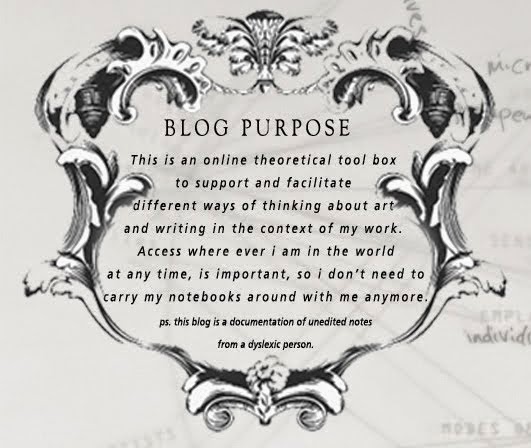Searching for Art's New Publics. 2010 Jeni Walwin
Chapter 16 - Co Productive Exhibition-making by Paul O'Neill.
A Collective Curatorial Methodology
Curating : Structures the exhibition experience for viewers. It orders the spatial relations between the work.
The audience perform their own experience of culture (p203). Which is relational.
Paul O'Neill uses an experimental curatorial approach. He represents new discursive space around art practice. Where curator, artists and critics contributed to the formation of the production and dissrmination of the show. Revealing the hidden curatorial components of an exhibition.
Paul’s methodology of Co-production of an exhibition:
Going beyond curatorial
planning. A collective curatorial methodology. (My understanding of what he is
saying)
1.
Showing how the actions of the curator mediated
the viewer.
2.
The implementation of thematic displays (traditional
curating strategy) are resisted.
3.
The works are not arranged to demonstrate a
coherent intertextual relationship (where each artist’s work relates to
particular texts. And therefor relate to each object through these texts).
4.
Divergent artistic practices are exhibited
together as one set of artworks. One category or rubric.
5.
So the artworks relate to the space they are in
and between each piece, rather than the theme the curator is suggesting the
viewer to see the work through what they have written about their chosen works.
6.
The evolving process of positioning and
arranging and placing works (reconfigurations of setting up the show) is
revealed and part of the exhibition. So the exhibition may likely change
throughout the duration of the show being open to public.
7.
The curator is working directly with the atists
in the process of positioning.
Step 1: Work directly with artists on every aspect of the
exhibition.
Step 2: Gather forms across a series of distinct exhibition
moments.
Step 3: Each exhibition moment takes the form of a mutating
environment or overlapping artworks.
Step 4: Consider this as a tool for an on-going
collaborative process.
Step 5: Artists work collectively in a semi-autonomous way
on the installation.
Step 6: Each artist becomes a participant within the
exhibition, the dialogue between the
participants becomes a piece of the work, an object.
Outcome Goal:
1.
There is no unified way of reading the artworks
or exhibition.
2.
The viewer/visitors perform their own experience
of culture in an unprescribed way. This unfixed framework tests the traditional
organisational structures of curating.
3.
To accommodate and cross fertilize different
artistic and curatorial positions in one space.
This represents a new discursive space around artistic
practice.
It is an ‘expanding exhibition-form.
Collaborative and collective exhibition making structures

